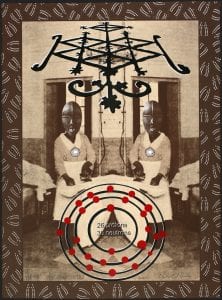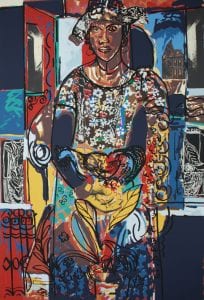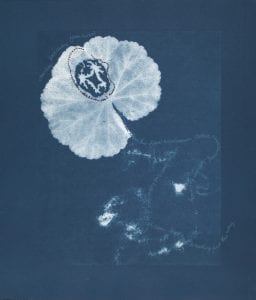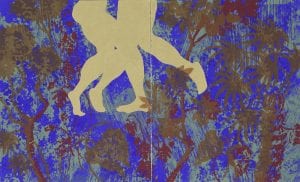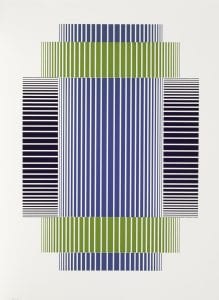
- This event has passed.
th(ink)ing
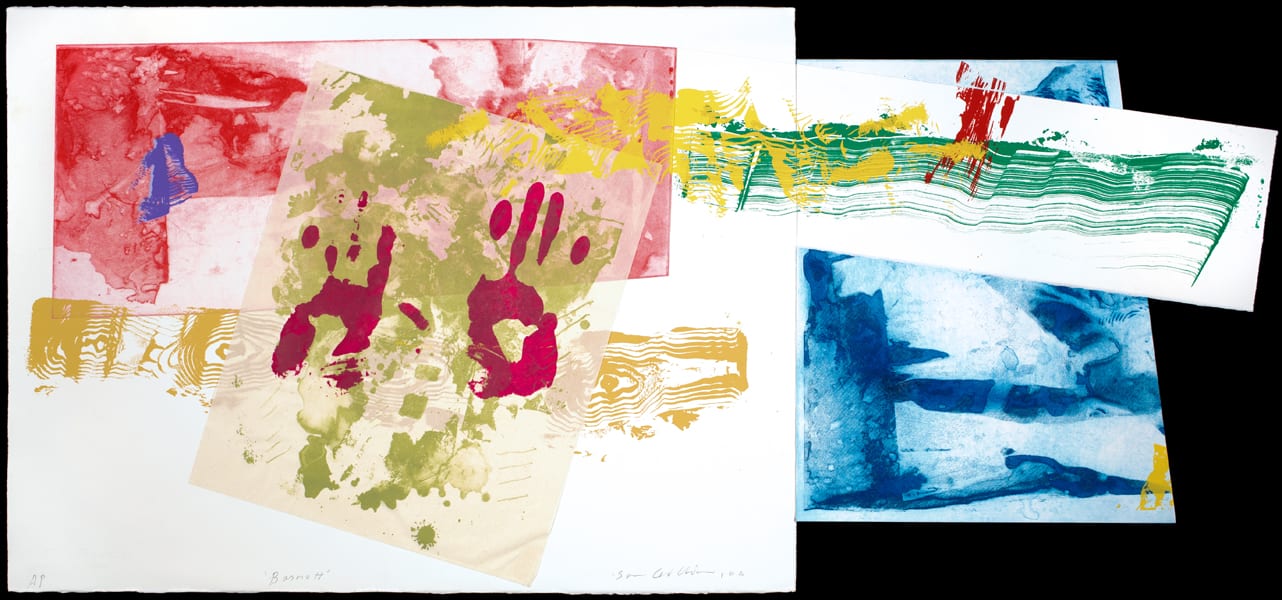
The Experimental Printmaking Institute at Lafayette College
Curated by Susan Ellis and Ricardo Viera
Introduction by co-curator, Susan Ellis
An important aspect of the Experimental Printmaking Institute (EPI) is the commitment to provide opportunities for diverse artists to create new works on paper. EPI’s founding director and master printmaker, Curlee Raven Holton, has developed residencies with a particular focus on Latin American artists, African American artists, and woman artists and many of these residencies have resulted in lasting creative relationships between the artist and Holton. One such artist, Faith Ringgold, first came to Lafayette in 1997 as visiting lecturer. Holton had prepared an etching plate for her in the hopes that she would respond favorably. He placed the plate in front of her and she proceeded to draw her iconic image of Cassie flying up over the George Washington Bridge. The etching, Anyone Can Fly, 1997, was the first of more than 40 prints and portfolios created together at EPI. This exhibition features the etching, Coming to Jones Road Under a Blood Red Sky, #6, 2005. The print is part of a series of works Ringgold created in response to her move to New Jersey. In 1992, Ringgold purchased a house on Jones Road in Englewood, New Jersey, across the river from her Harlem birthplace and not far from the bridge Cassie flew over in Anyone Can Fly. Her dream of constructing a studio and garden became difficult when she found herself surrounded by hostile neighbors who viewed her presence in the neighborhood as a threat to their “quality of life.” Her knowledge of ancestors on the Underground Railroad helped her find the inspiration to turn her traumatic experience into a remarkable series of works. After 6 years of battling the town, she finally succeeded in building the studio addition to her house where she continues to live and work today.
Holton’s vision for EPI is to provide artists with the time, space, materials, and professional support to create new work. EPI encourages artists to experiment with new techniques in order to invent novel solutions to problems. The resulting experimentation often combines multiple printmaking processes in order to achieve a desired effect. For instance, David C. Driskell’s Woman in Interior, uses serigraph, relief, collage, and digital techniques to produce the textured, layered, depth reminiscent of Driskell’s paintings. This spirit of exploration is also evident in Sam Gillam’s Strokes series, a progression of seven unique images ending with Barnett, 2007, included in this exhibition. Each successive print in the series builds upon the previous piece with the addition of new elements. Perhaps more than any other artist associated with EPI, Gilliam has championed experimental approaches and investigated new ways of thinking about printmaking.
Since EPI is situated within an academic institution, it has always involved students in the creative process as part of its mandate. Students work side by side with artists assisting with the printmaking process and with other aspects of EPI including research, design, and curatorial work. Holton has also drawn on the resources of Lafayette College by developing collaborations with other departments. When noted artist Richard Anuszkiewicz visited Lafayette College to give a lecture, Holton had prepared a plate for him by creating a deeply bitten relief etching which mimicked the structural style of Anuszkiewicz’s painting. Anuszkiewicz walked into the studio shortly after his talk to find Holton and a student relief-rolling the plate and he immediately recognized the potentials. Holton invited him to return and they took Anuszkiewicz’s original drawing to Lafayette’s Department of Engineering where they scanned it into a computer and then precisely laser cut a plate that became the matrix by which Intersecting Blues was created. That piece went on to be shown in Europe at a number of retrospective shows of Anuszkiewicz’s work.
Holton has taught printmaking and African American art history at Lafayette College since 1991. Before coming to Lafayette, he had completed a residency with the famous master printmaker Robert Blackburn at his Printmaking Workshop in New York City. Seeking a similar communal printmaking experience, Holton found space on Lafayette’s campus in a former garage facility and proceeded to create a unique creative classroom for students and internationally famous artists. In Holton’s words, “The inherent nature of the printmaking medium encourages a communal participation by artists and students alike.” Since EPI was established, more than 150 artists have created new works on paper and contributed to the printmaking canon. This exhibition honors and celebrates almost twenty years of continued experimentation and creative innovation in the printmaking medium.
–Susan Ellis served as the Director of Programs for the Experimental Printmaking Institute from 2001 until 2009. She earned a Bachelor of Fine Arts from the Tyler School of Art, Temple University and is currently pursuing a Master of Science in Teaching, Learning, and Technology from the College of Education at Lehigh University.
A CONVERSATION BETWEEN CURLEE RAVEN HOLTON, FOUNDING DIRECTOR OF EPI AND RICARDO VIERA, LUAG DIRECTOR AND CHIEF CURATOR.
RV: In the contemporary world of visual communications media, what special or unique role does the art of printmaking play?
CH: The re-application of technology originally devised for commercial purposes has been part of the history of the fine arts in Europe since the 16th century. In non-European countries, it goes back further to where crude wood stamping tools and plant dyes were used to produce multiple images.
In what has been referred to as the ‘modern’ art world, artists of major stature such as Francisco Goya–often thought of as the first modern artist–and Pablo Picasso utilized what we now consider traditional printmaking forms to produce fine art prints as a part of their larger creative oeuvre. However, in the first part of the 20th century, the art world was permanently altered, as were most aspects of modern society.
RV: A lot of ‘isms’ or new movements were formed. What happened particularly in printmaking?
CH: A new sense of existentialism and dread began to replace traditional and predictable societal practices and behaviors. This new social environment resulted in dramatic new forms of creative expression that broke from the past. Art movements like early Modernism re-contextualized and appropriated ritual objects and image-making processes that led to the birth of Abstraction and Abstract Expressionism.
This new generation of art rebels now viewed the grand inheritance of the past as a yoke to be thrown off. In its place, they sought a freedom of expression and experimentation that combined private studio practices with new industrialized technologies and materials born of war and science. They launched their ideas into the industrial spaces of the present rather than the private and intimate ateliers of the past.
RV: How did the democratic nature of print production play a part in the acceptance of printmaking within the established art world?
CH: Led by artists such as Stanley Hayter–who fled Paris during the Nazi occupation and established his Atelier 17 in New York City–printmaking took on a new artistic meaning. Hayter and others set the stage for the graphic art of printmaking to become a central form of expression. For them, it exemplified the ideal of a visual communicative form that was also an affordable art making technology. Printmaking could produce a singular object or multiples for the masses. Artists such as Jackson Pollock and Mark Rothko made prints at the New York Atelier 17. Later, artists like Robert Rauschenberg and Andy Warhol took printmaking technologies to a new level, releasing the creative possibilities of printmaking as both a tool of visual communication and contemporary social commentary.
RV: The term ‘experimental’ has been used in different ways throughout history. I am curious to hear why you chose it for the name of your original classroom project at Lafayette? In what way or ways is EPI experimental?
CH: As an art student, both as an undergraduate at the Cleveland Institute of Art and at graduate school at Kent State University, I had always been attracted to pushing the bounds of the materials I worked with. By combining diverse mediums I sought to achieve a more tactile or dramatic quality in my artwork. Upon reflection I believe this challenging of traditional practices was connected to my desire to communicate with the voice of an outsider or non-conformist. This sense of experimentation with traditional and non-traditional materials was further encouraged during my participation in a NEA Fellowship program at the famous Robert Blackburn Printmaking Workshop in New York City.
RV: Blackburn was thought of as the dean of printmaking within the African American art community. He was one of the first professionally trained master printers.
CH: While working at Tatyana Grosman’s Universal Limited Editions (ULEA) workshop in 1963, Bob was the master printer with Robert Rauschenberg when the stone he was working on broke in two. After the incident it was reported that Blackburn became physically ill and was so embarrassed by the event that he stopped printing and left the U.S. to ride across Europe on a motorcycle. This broken stone–thought to be Blackburn’s fault–became immortalized when Rauschenberg incorporated the crack into his final image.
Now, in the collection of the Museum of Modern Art, Accident embodies Rauschenberg?s genius for turning chance events to artistic advantage. Accident went on to win first prize at the 1963 Ljubljana Graphic Biennial and established Rauschenberg and ULEA at the forefront of American printmaking.
RV: Let’s get back to EPI. How did your experiences with Blackburn’s workshop inform EPI’s educational roots?
CH: In 1996 I founded the Experimental Printmaking Institute at Lafayette College as a program partly inspired by Bob Blackburn’s passion and commitment to the communal nature of printmaking. I wanted to encourage students to challenge their preconceived notions of art-making and to give them permission to experiment in the environment of a creative laboratory classroom. Experimentation in the printmaking studio has a lot to do with problem-solving. EPI provided an opportunity for students to work alongside established artists from all mediums with the shared goal of creating new and innovative works of art that otherwise would not be made.
This sense of innovation and experimentation has always been a creative inspiration to me as an artist and printmaker. My studio and teaching career can best be described as a merging of my traditional training and love of the masters with a measured sense of experimentation linking the fractured realities of contemporary life.
RV: What is art/printmaking to you, in this new millennium?
For me art of the Millennium represents two very important possibilities. The first is public accessibility and the second is mutability. Accessibility is achieved with the aid of technological mechanisms that provide augmented engagement along with actual individual audience encounters with the art object or art per formative experience. The second is the mutability, or constant potential for change and alteration. The art of printmaking and its dynamic variations offer a creative medium that allows for the intersections of studio based art practices and new technologies. This intersection has the capacity to generate visual awareness in new and distinct ways. This matrix allows the artist the freedom to produce creative mutations and alterations that generate singular or multiple images.


